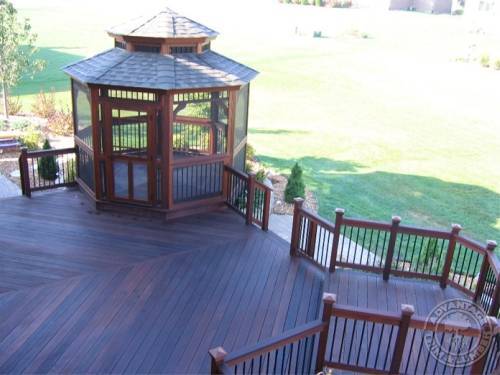The best way to prevent decking problems is to ensure that your deck was installed correctly in the first place.
Here are five crucial steps that will prolong the life of your deck:
1) Buy decking that is premium grade. When shopping for exotic hardwoods like ipe, it’s important to know the difference between premium/clear grade and common grade.
- Common/Select Grade – Contains sap wood and visible knots & worm holes. Common grade also can be poorly milled (called hit and miss planing). Common grade also has a huge color variance from very light blond to almost black wood.
- Premium/Clear – Best grade, period. All heart and no sapwood. Carefully milled material which highlights the well-blended colors with some boards showing their natural accents.
2) Use an end sealer prior to installation. This is a critical part of decking installation and will help prevent future problems. Learn more about end grain sealer.
3) Apply deck oil. Choosing the right deck oil finish for ipe or any other hardwood decking will be prevent many problems including warping, checking, splits, and cracks.
4) Use a deck fastening system. Using hidden deck fasteners not only make your deck surface more attractive, but they also allow your new deck to expand and contract throughout the course of its life without much impediment.
5) Properly straighten bowed deck boards. Installing bowed boards, or forcing them in with flimsy tools and methods might save you some install time, but in the long run, you might also be decreasing the overall structural integrity and look of your deck. Nothing is a bigger pain that having to repair boards that get loose from the joist. Using deck tools like the Hardwood Wrench® will save you the headaches (and backaches) of having to make future repairs.
6) Don’t rush. When you take care in the installation process, you’ll find that you:
- Get more enjoyment out of installing wood decking
- End up with a stronger, and better looking deck
- Gain years of personal enjoyment out of using it
If you breeze through any of these steps, or skip one of them, you might end up having to put more time and work into maintaining your deck. Ultimately, these decking products will greatly enhance the look and performance of your future deck. If you have any other questions, or would like to speak to a professional, contact us.

What happens if you use tongue & groove Ipe on an exposed deck?
If Tongue and Groove material is used on a deck without adequate cover or a pitch rain water will pool on the surface. Your deck will also not be properly proper ventilated.
This, in turn, will create a cupping or buckling issue. The wood decking will begin to shrink or expand to compensate for the amount of moisture it will be dealing with.
If you want a smooth looking surface, we suggest that in uncovered outdoor applications that you use the Ipe Clip® brand deck fasteners. These hidden deck fasteners will allow for a gap between the boards in turn allowing for proper drainage as well as helping with ventilation.
I hope this helps. Please let us know if there is anything else that we can assist you with. Thank you for your time.
Grooved Ipe decking laid on the diagonal – The bow wrench will not work 90% of the time on this angle. We have found that if you can start your decking with a 6′ pry bar wedged in the ground and pressed against the board or a come-along attached to a post. After a few boards are laid, you can use a strap wrench dropped through the board and around the front of the new board being laid. This works like a charm. We are doing a chevron pattern and this was the best method.